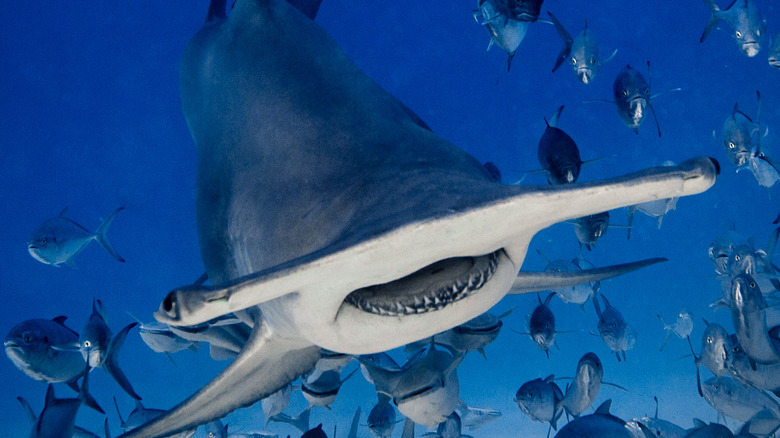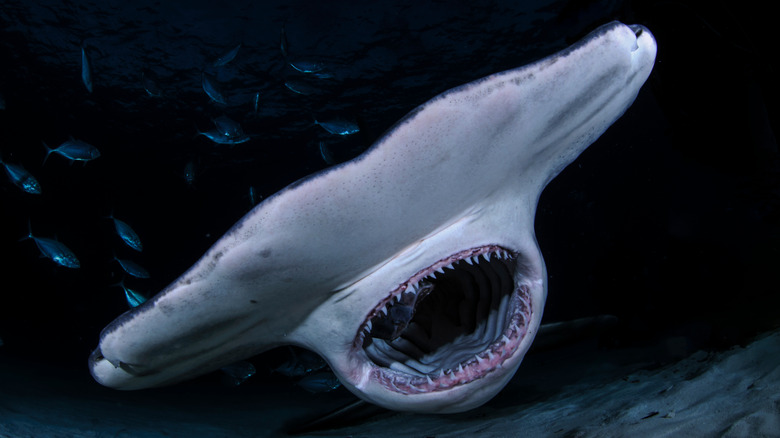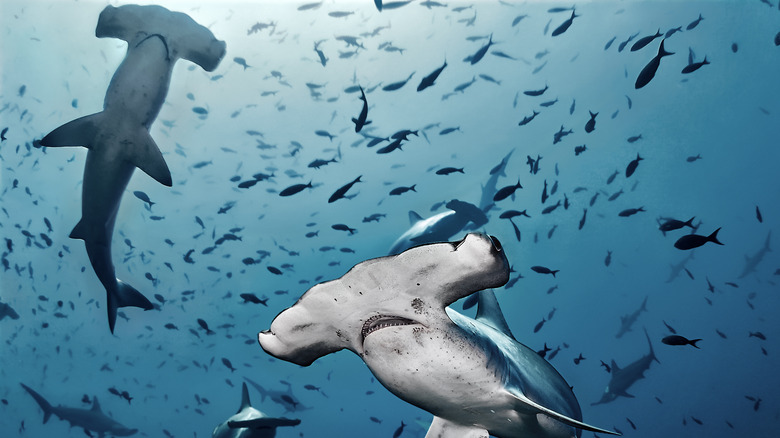The Biggest Hammerhead Shark Head Shape Theories Explained
A dive in the deep blue can conjure some pretty freaky-looking creatures. From fang-covered faces and crawly red hands to vampire squid swirling through the ocean waves (via Best Life), the sea offers quite the eyeful, some of it quite terrifying. For us mere mortals, perhaps the most horrifying sight of all is one of a massive shark with a hammer-shaped head plunging through the waters.
According to Britannica, the hammerhead shark stalks the coasts and continental shelves with ease, a natural-born hunter with some very distinct features. They're viviparous — they retain their fertilized eggs within their bodies, with live births of anywhere from two to 42 young. The sea-dweller sports a toothy grin built to take a bite out of any creature daring enough to cross its path. The hammerhead shark is unique anatomically, but is having a head shaped like a hammer all that it's cracked up to be? According to scientists, yes; but there are conflicting opinions as to why (via X-Ray Mag).
Enhanced senses for better predation outcome
X-Ray Mag reports that many scientists believe the hammer-shaped head really drives a nail in the coffin of this massive shark's prey by giving the predator superior vision and enhancing many other sensors in the process. This popular theory suggests that there are multiple sensory advantages to the cephalofoil phenomenon — the scientific term for the flat, oblong head shape seen on this shark (via Bio Web).
Adherents to this theory believe this unique head shape gives the maritime predator the advantage of 360-degree vision, sometimes referred to as binocular vision, not to mention a keener sense of smell. Inhibiting a body with bigger nasal tracts than other sharks could mean having a superior sense of not only odors in the ocean, but also of the electrical field, which is a key component for tracking and hunting. If these scientists are correct, the hammerhead shape could be the reason these sharks possess the unparalleled ability to distinguish between DC fields and AC fields, resulting in an advantageous position even among other big fish.
Superior hydrodynamic properties
Another theory that seems to hold water is the idea that the long, flat-top head serves as a kind of wing cutting through the waters and giving the shark superior hydrodynamic abilities and maneuverability (per X-Ray Mag). This can be seen in the speedy shark's ability to turn and flee from other predators, as well as change directions with ease in pursuit of its own prey. This hydrodynamic theory suggests that the hammerhead shark is a bit like an ocean-born fighter jet, using its head like a pair of wings. Proponents of this theory claim the head provides more lift, for better buoyancy in the misty waters of the deep.
Several experiments have been conducted to test these theories, with varying results. It's clear that the unique shape of the head provides numerous advantages, though which was most important in terms of evolution is still debated. Regardless of this difference in opinion, one thing remains clear: Having a head shaped like a hammer is both an odd and advantageous feature for a shark.


